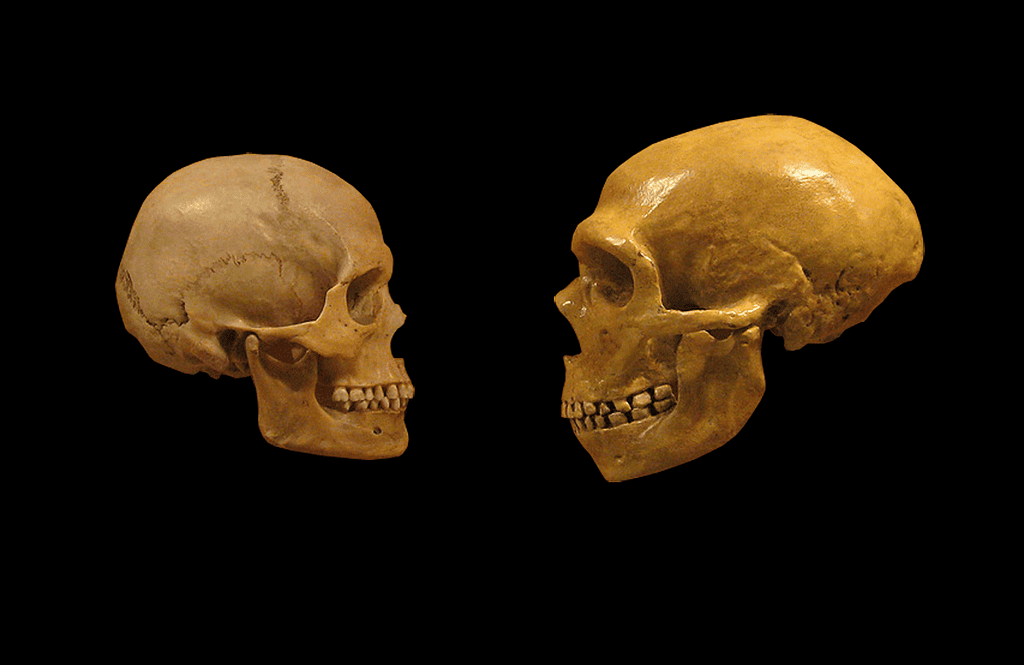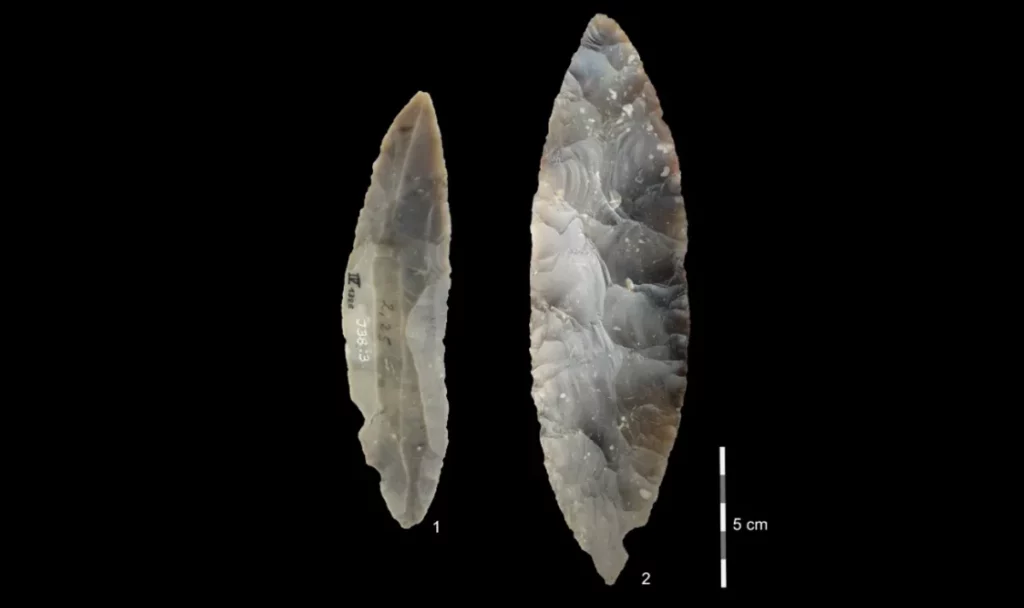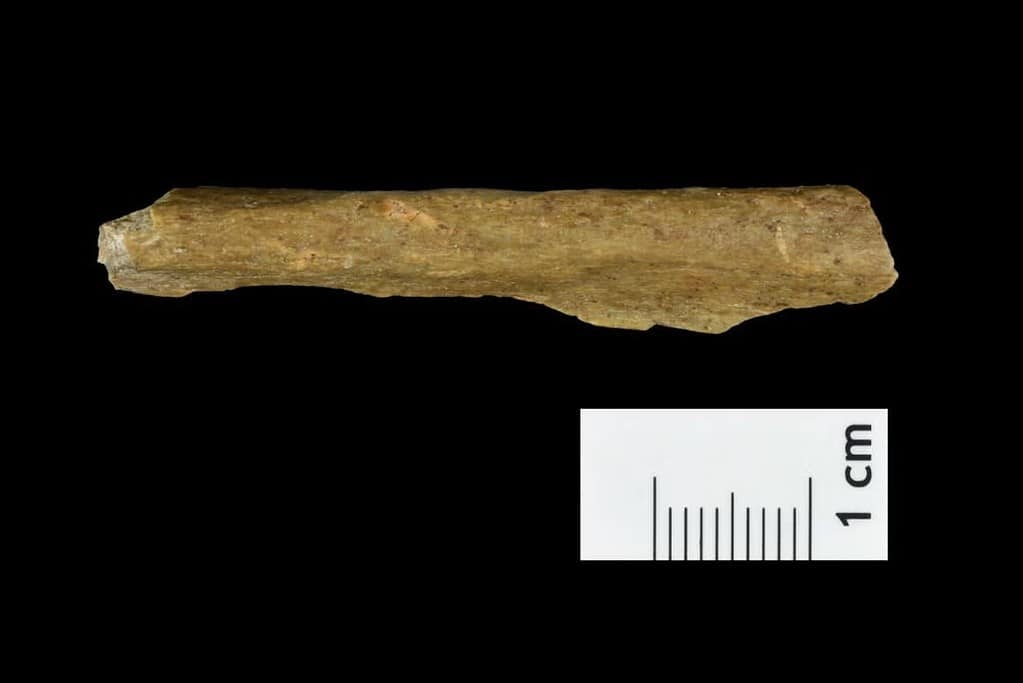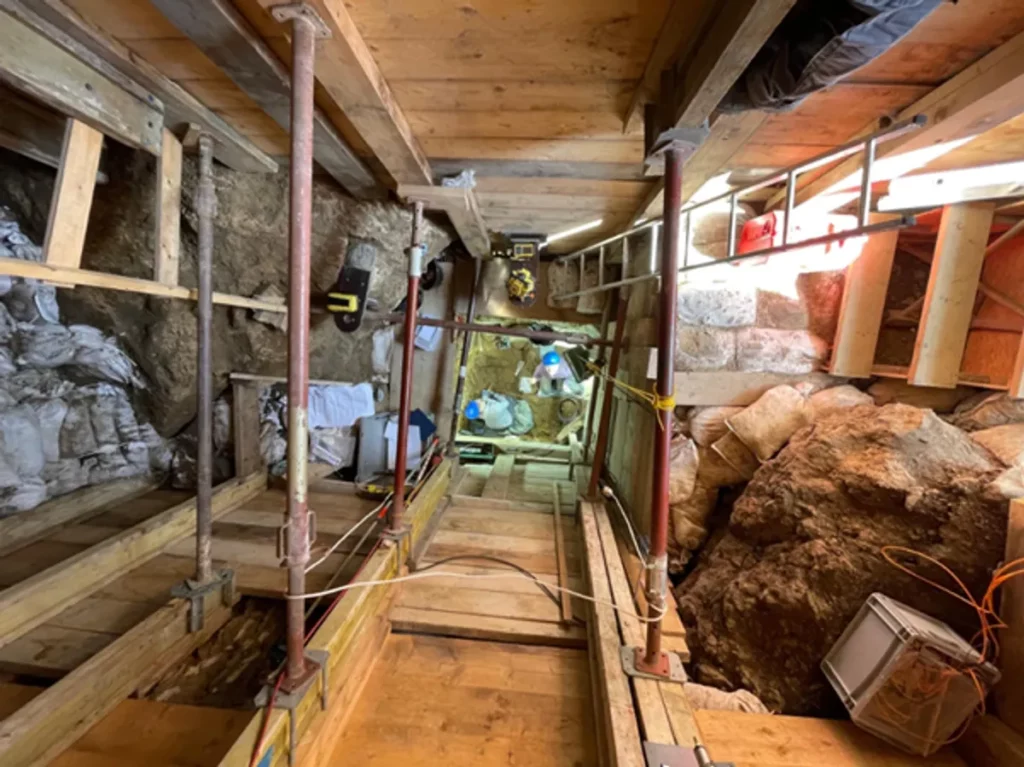
In the rolling hills of central-eastern Germany, nestled near the quaint town of Ranis, lies a cave that has unlocked a secret more than 45,000 years old. This secret reveals a time when our human ancestors shared the cold, vast landscapes of Northern Europe with the Neanderthals.
Recent discoveries at this archaeological site have now shed light on this pivotal moment in human history. The new findings show that Homo sapiens ventured further north much earlier than previously believed. What’s more, they did so during a particularly grueling cold period.
A meeting of two worlds
Not one, but three studies out at the same time today have unraveled the complex and often mysterious story of how two species from the same human lineage finally met. Before this Homo sapiens and the Neanderthals had split from a common ancestor more than 600,000 years ago, diverging from Homo heidelbergensis or Homo antecessor or perhaps another species. We’re not sure yet.
Although there was no one to write all of this down and forever record this epic meeting in history, we’ll have to settle for the second-best thing: ancient artifacts, bone fragments, and precious DNA samples that all fit together like a giant jigsaw puzzle.
It all starts with the Ilsenhöhle cave in Ranis. This place has been a big deal in archaeology and paleontology for over a century. It is here that researchers have previously found the remains of denning hyenas, hibernating cave bears, and a myriad of other long-extinct and forgotten creatures. And, as it so happens, they've also found also some stone artifacts.
These long, leaf-shaped stone bits belong to the Lincombian-Ranisian-Jerzmanowician (LRJ) culture. But what has always been rather mysterious is whether modern humans or Neanderthals were responsible for LRJ. The problem is that excavations — mostly poorly done in the early 1900s — weren't able to associate bony remains with the artifacts.

Several sites across northern Europe have been associated with the LRJ, and all but one have been destroyed by prior crude excavations. This explains why an international team of researchers revisited Ilsenhöhle, where there were still some unexcavated sections, hoping they could finally find remains that may answer this ancient riddle.
A team led by archaeologists at the Max Planck Institute for Evolutionary Anthropology, Thüringisches Landesamt für Denkmalpflege und Archäologie, and Friedrich-Alexander-Universität Erlangen-Nürnberg re-excavated the cave, digging deeper into the sediment layer than anyone had done before. It was a long and arduous process performed in the freezing cold. The archeologists had to dig by hand through 8-meter-deep sediment, including pieces of rock and debris that had collapsed from the cave roof.
Finally, they struck gold, discovering many fragments of bone. Subsequent chemical analysis of the collagen from the samples revealed the remains belonged to 13 distinct hominins. But which type of hominin: humans or Neanderthals?

LJR: Lost and found
That's where the genetic analysis entered the picture. Elena Irene Zavala, a postdoc at the University of California, Berkeley, sequenced the DNA extracted from the bones. It wasn't as straightforward as it sounds. It's not like you can get a nice cotton swab saliva sample mailed to your lab. Even preserved through the eons by the cave's constant environment, the DNA was naturally of poor quality.
Luckily, scientists have developed methods over the past decade that can amplify and extract usable information even from very old and deteriorated DNA. Specifically, the scientists extracted mitochondrial DNA, which we inherit solely from our mother's side. Scientists also looked at the protein composition of the bone fragments, which can also determine the hominin species.
Ultimately, the analysis undoubtedly showed that the bones, and consequently the masters of the LRJ technology, were modern humans — along with another important revelation.
"Our finding that it was Homo sapiens (humans) who were the makers of the LRJ is exciting in itself. In addition, Helen Fewlass was able to determine that these bones were over 45,000 years old. This means that Homo sapiens arrived in northwest Europe earlier than we previously thought," Zavala told ZME Science.

Credit: Marcel Weiss, License: CC-BY-ND 4.0.
What's interesting is that several of the DNA samples shared mitochondrial DNA sequences. This suggests that they were kin.
"That several of the fragments have the same mtDNA can indicate that the remains were from the same individuals. Given several were small fragments, this is very possible. Or that they were from maternal relatives. To determine insights related to family structure we would need to perform nuclear DNA analysis," Zavala added.
The trio of papers on the matter also employed both genetic and chemical analysis on some of the animal remains from the cave. This showed that the climate in this part of Europe at that particular time was very cold, more like you would expect today in Scandinavia or even Siberia. The presence of reindeer and woolly rhinoceros bones paint the scene of a harsh, tundra-like environment, challenging the inhabitants' survival skills.
"These humans produced a distinctive set of stone tools, known as the Lincombian-Ranisian-Jerzmanowician (LRJ) technocomplex, characterized by blade points and leaf points. Until now, it had remained heavily debated if these stone tools were produced by Neanderthals or Homo sapiens. Our findings now push back the earliest presence of our species in NW Europe and this is especially important since it shows Homo sapiens were already present in large parts of Europe when groups of Neanderthals were still present in SW Europe. Overall, our work highlights the early arrival of small groups of Homo sapiens in NW Europe alongside their successful behavioral adaption to cold, open environments," Geoff Smith, a zooarchaeologist at the University of Kent and co-author of the study told ZME Science.
"These blade points have been found from Poland and Czechia, over Germany and Belgium, into the British Isles and we can now assume they most likely represent an early presence of Homo sapiens all over this northern region."
There's another thing. The researchers concluded that Ilsenhöhle cave was inhabited over the years by cave bears and hyenas. Humans ventured there only temporarily, judging from the much larger ratio of cave animals found at the site. The implication is that the LRJ people at Ranis didn't belong to some long-established group, but rather represented some early pioneers. Perhaps they were among the first — if not the first — Homo sapiens to ever venture this far north into the old continent.
So where does all of this leave the Neanderthals? This was their home turf after all. We've of course known for a long time that modern humans and Neanderthals met and mingled. They even interbred. So much that up to 2% of the DNA of people of European or Asian ancestry is Neanderthal, although sub-Saharan Africans share zero Neanderthal DNA.
The final chapter in the story of Neanderthals is still a mystery
These new findings show that Homo sapiens was undoubtedly in central and northwestern Europe long before the last Neanderthals perished around 40,000 years ago. Just imagine, for thousands of years, Europe was shared by two distinct species of humans. They traded, had sex with one another, and likely fought each other for control of dwindling resources in times of climate change.
It's an entertaining thought to ponder. However, the new findings can't say anything about how exactly Neanderthals went extinct. That's still a big yet very open question.
"Current data, including our new data from Ranis, is extending the period of geographic and chronological overlap between Neanderthals and Homo sapiens in Europe. It’s difficult to know whether these small-scale influxes of early groups of H. sapiens impacted on local Neanderthal groups, especially considering the latter’s predicted small and dispersed group sizes."
"It is interesting that the diet of both these early H. sapiens and late Neanderthals appears to be focused on large terrestrial game, which could have led to areas of competition. I think a combination of rapidly fluctuating climates combined with small population sizes undoubtedly put stress on late Neanderthal populations. However, we still need additional data points to more fully understand the role and impact of climate and incoming H. sapiens groups in the eventual disappearance of Neanderthals in Europe," Smith said.
The tale of Ranis is a chapter in the larger story of humanity, a story that continues to evolve with each new discovery in the depths of caves and the sequences of DNA. In tracing the footsteps of those who walked the earth before us, we gain not only knowledge of our origins but also an appreciation for the resilience and ingenuity that define our species.
"Our work has fundamental implications not only for the earliest Homo sapiens occupation of Europe but also for the earliest occupation of the UK. The stone tools we found at Ranis, directly associated with these earliest Homo sapiens, were also found at sites across the UK, for example at Kent’s Cavern (Devon). With the latest scientific methods at hand now, we can fully start reassessing other LRJ sites to further help us understand when and how these earliest Homo sapiens pioneer populations lived and adapted in north-western Europe more than 45,000 years ago," Smith added.
All three studies appeared in the journal Nature:
- Homo sapiens reached the higher latitudes of Europe by 45,000 years ago
- Stable isotopes show Homo sapiens dispersed into cold steppes ~45,000 years ago at Ilsenhöhle in Ranis, Germany
- The ecology, subsistence and diet of ~45,000-year-old Homo sapiens at Ilsenhöhle in Ranis, Germany


